
- SAP Community
- Products and Technology
- Enterprise Resource Planning
- ERP Blogs by Members
- Split Production Order
- Subscribe to RSS Feed
- Mark as New
- Mark as Read
- Bookmark
- Subscribe
- Printer Friendly Page
- Report Inappropriate Content
Index
Introduction..
Configuration Settings.
Step I: Define Order Type dependent parameters (OPL8).
Transactional Setting..
Assumptions:.
Step I: Create Production Version for finish material SPLT_1000 (C223).
Step II: Create Product Cost Collector for finish material SPLT_1000 (KKF6N).
Process Flow Steps.
Step I: Create & save with release production order (CO01).
Step II: Confirm the production order (CO11n).
Step III: Change production Order (T-Code CO02).
Step IV: Confirm production Order (T-Code CO11N).
Step V: Goods Receipt for Production Order (MIGO).
Restrictions.
Introduction
Order split enables us to split an existing production order, for which processing may have already begun, into two separate production orders. These production orders are then executed separately from a logistics perspective. We might want to perform an order split for the following reasons
· When a partial lot of a production order has to be handled differently than the rest due to quality reasons, you can create a separate order to do this.
· If capacity bottlenecks occur, the portion of the order quantity that is required immediately can be processed separately.
· The material availability can only be confirmed for part of the order quantity. You split the order to create an order with full material availability.
· If the required date for a partial quantity of the finished material has changed, this portion can be split off in a different order.
· If a production order cannot be completed on time, you can split the order to reduce the order quantity. The reduced order quantity then requires less time to produce.
When we split an order, we split off part of the order quantity (split quantity) of a production order (parent order) from a certain operation of the standard sequence (split operation). The quantity that is split off is produced in a separate production order (child order). In the process, the operations from the split operation onwards are copied from the parent order to the child order, along with the assigned material components. The system automatically recalculates all the quantities affected by the order split, as well as dates at header, operation, and component level.
In this article process steps are explained with an example considering following assumptions.
· There is only a standard sequence in use and no alternative sequences.
· There is no in process inspection.
· No Serial Number assignment.
Configuration Settings
Step I: Define Order Type dependent parameters (OPL8)
SPRO --- Production --- Shop Floor Control --- Master Data --- Order --- Define order type-dependent parameters
For required order type, Activate check box Cost collector and define Default Rule as “PP2” - Production Mat. Period. Settlement

Transactional Setting
Assumptions:
Following are has been created already:
1. Finish Material SPLT_1000 – with selection method 3 (MRP 4 view)

2. Bill Of Material
3. Routing
Step I: Create Production Version for finish material SPLT_1000 (C223)

Step II: Create Product Cost Collector for finish material SPLT_1000 (KKF6N)


Note: There should be order type with order category as 05
Process Flow Steps
Step I: Create & save with release production order (CO01)
Create production order for SPLT_1000 material with order type PP01 and with quantity 100 EA.


Out of total four operations, confirm first two operations with actual operation quantity.
Order split is allowed with following system status:
· Header Status: Partially released, released, partially confirmed.
· Operation Status of the split operation and all successors: Created, released, partially confirmed
The order split is not allowed with the following status:
· Header status: Created, delivered, finally confirmed, locked, technically complete, closed, deletion indicator set
· Operation status of the split operation and all successors: Finally confirmed, dispatched, partially dispatched, capacity split, capacity requirement assigned, capacity requirement partially allocated
· Operation status of the split operation: Deleted.
Step II: Confirm the production order (CO11n)
Confirm Operation 0010 & 0020 as below:


Step III: Change production Order (T-Code CO02)
Split the production order with split quantity 37 EA from operation 0030.
In production order operation overview, select the operation 0030 and go to functions menu and click on split order.
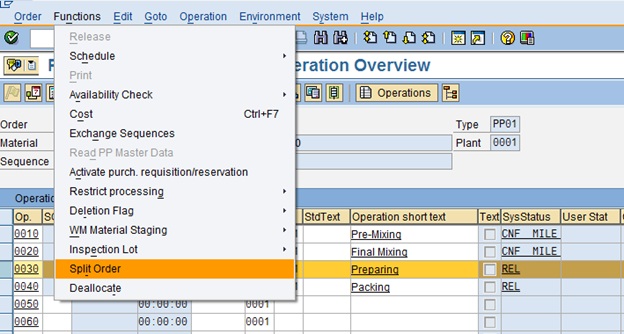
Enter required split quantity in split quantity field. Here we can select different order type for child order. And further system will also allow us to schedule the child order with different dates.
After entering all parameters, execute split (click on split order execute button).
System will create a child order with specified parameters and it will be displayed along with parent order in split hierarchy.
The split hierarchy displays the dependencies between the parent and child orders in an overview tree. During order maintenance, the split hierarchy and the selected order from the split hierarchy are displayed. We can navigate to any order in the split hierarchy (tree structure).
Orders (including child orders) can be split several times. The dependencies can be seen in the split hierarchy.


After splitting Order, system will set the status SPLT (Split) at header and operation levels for parent order and split qty. as expect yield variance.
Operation qty. will be reduced to 63 PCs. from operation 0030 to the succeeding operations.
System will set the status CSPL (created by splitting) at header level for child order (1000315). All successive operations from split operation (including split operation) will be copied to the child order along with all assignments (for example material components, PRTc etc...)
For child order we can check the reference order (1000314) in controlling data tab.
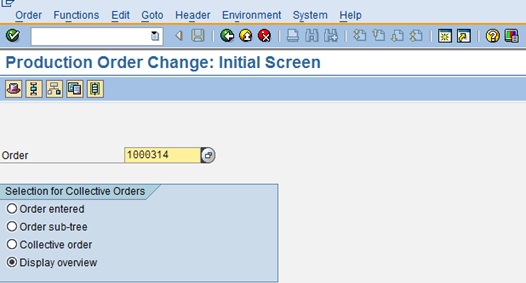


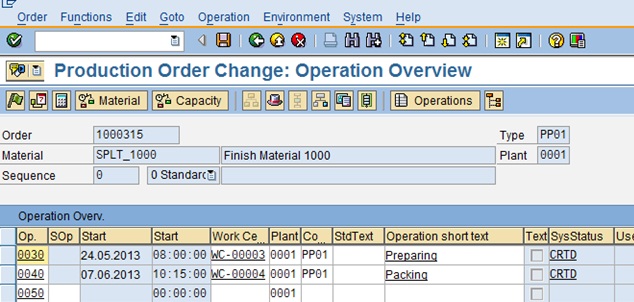
Step IV: Confirm production Order (T-Code CO11N)
Confirm the rest operation of parent production orders i.e 1000314. You will found Yield quantity as 63 (Because Parent order quantity – Spitted Quantity i.e 100 – 37 = 63)


Likewise Confirm Child order 1000315
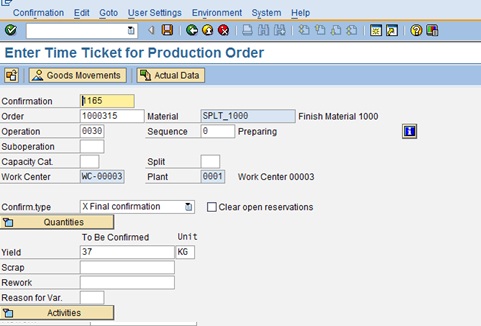
Step V: Goods Receipt for Production Order (MIGO)
Perform Goods receipt for both orders with their respected yield quantities.
In this case delivered quantity for the parent order (1000314) is 63 EA. For child order (1000315) final delivered quantity is 37 EA.

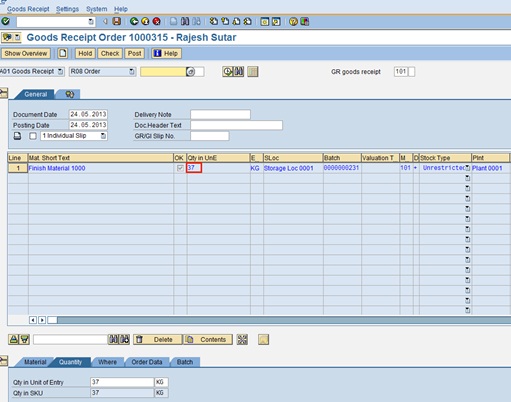
Go to T-code CO03 to see Reference order of Child order

Restrictions
The following restrictions apply to the order split:
· The parent order and child order must both be settled to the same product cost collector
· We cannot read master data for the orders in a split hierarchy
· Orders in a collective order cannot be split
· Orders of a split hierarchy cannot be supplemented with a sub tree
· The parent and child order must both have the same header material
· We cannot perform confirmations at order header level
· The batch where-used list is not updated during order split.
- SAP Managed Tags:
- MAN Production Planning (PP)
You must be a registered user to add a comment. If you've already registered, sign in. Otherwise, register and sign in.
-
"mm02"
1 -
A_PurchaseOrderItem additional fields
1 -
ABAP
1 -
ABAP Extensibility
1 -
ACCOSTRATE
1 -
ACDOCP
1 -
Adding your country in SPRO - Project Administration
1 -
Advance Return Management
1 -
AI and RPA in SAP Upgrades
1 -
Approval Workflows
1 -
ARM
1 -
ASN
1 -
Asset Management
1 -
Associations in CDS Views
1 -
auditlog
1 -
Authorization
1 -
Availability date
1 -
Azure Center for SAP Solutions
1 -
AzureSentinel
2 -
Bank
1 -
BAPI_SALESORDER_CREATEFROMDAT2
1 -
BRF+
1 -
BRFPLUS
1 -
Bundled Cloud Services
1 -
business participation
1 -
Business Processes
1 -
CAPM
1 -
Carbon
1 -
Cental Finance
1 -
CFIN
1 -
CFIN Document Splitting
1 -
Cloud ALM
1 -
Cloud Integration
1 -
condition contract management
1 -
Connection - The default connection string cannot be used.
1 -
Custom Table Creation
1 -
Customer Screen in Production Order
1 -
Data Quality Management
1 -
Date required
1 -
Decisions
1 -
desafios4hana
1 -
Developing with SAP Integration Suite
1 -
Direct Outbound Delivery
1 -
DMOVE2S4
1 -
EAM
1 -
EDI
2 -
EDI 850
1 -
EDI 856
1 -
EHS Product Structure
1 -
Emergency Access Management
1 -
Energy
1 -
EPC
1 -
Find
1 -
FINSSKF
1 -
Fiori
1 -
Flexible Workflow
1 -
Gas
1 -
Gen AI enabled SAP Upgrades
1 -
General
1 -
generate_xlsx_file
1 -
Getting Started
1 -
HomogeneousDMO
1 -
IDOC
2 -
Integration
1 -
Learning Content
2 -
LogicApps
2 -
low touchproject
1 -
Maintenance
1 -
management
1 -
Material creation
1 -
Material Management
1 -
MD04
1 -
MD61
1 -
methodology
1 -
Microsoft
2 -
MicrosoftSentinel
2 -
Migration
1 -
MRP
1 -
MS Teams
2 -
MT940
1 -
Newcomer
1 -
Notifications
1 -
Oil
1 -
open connectors
1 -
Order Change Log
1 -
ORDERS
2 -
OSS Note 390635
1 -
outbound delivery
1 -
outsourcing
1 -
PCE
1 -
Permit to Work
1 -
PIR Consumption Mode
1 -
PIR's
1 -
PIRs
1 -
PIRs Consumption
1 -
PIRs Reduction
1 -
Plan Independent Requirement
1 -
Premium Plus
1 -
pricing
1 -
Primavera P6
1 -
Process Excellence
1 -
Process Management
1 -
Process Order Change Log
1 -
Process purchase requisitions
1 -
Product Information
1 -
Production Order Change Log
1 -
Purchase requisition
1 -
Purchasing Lead Time
1 -
Redwood for SAP Job execution Setup
1 -
RISE with SAP
1 -
RisewithSAP
1 -
Rizing
1 -
S4 Cost Center Planning
1 -
S4 HANA
1 -
S4HANA
3 -
Sales and Distribution
1 -
Sales Commission
1 -
sales order
1 -
SAP
2 -
SAP Best Practices
1 -
SAP Build
1 -
SAP Build apps
1 -
SAP Cloud ALM
1 -
SAP Data Quality Management
1 -
SAP Maintenance resource scheduling
2 -
SAP Note 390635
1 -
SAP S4HANA
2 -
SAP S4HANA Cloud private edition
1 -
SAP Upgrade Automation
1 -
SAP WCM
1 -
SAP Work Clearance Management
1 -
Schedule Agreement
1 -
SDM
1 -
security
2 -
Settlement Management
1 -
soar
2 -
SSIS
1 -
SU01
1 -
SUM2.0SP17
1 -
SUMDMO
1 -
Teams
2 -
User Administration
1 -
User Participation
1 -
Utilities
1 -
va01
1 -
vendor
1 -
vl01n
1 -
vl02n
1 -
WCM
1 -
X12 850
1 -
xlsx_file_abap
1 -
YTD|MTD|QTD in CDs views using Date Function
1
- « Previous
- Next »
- How to reproduce CO16N? in Enterprise Resource Planning Q&A
- The project system should automatically update the equipment usage counter in Enterprise Resource Planning Q&A
- Kanban with production orders: Scheduling of orders in Enterprise Resource Planning Q&A
- Sales order line item rejected even though MTO Production order has CNF and DLV status (Strategy 82) in Enterprise Resource Planning Q&A
- MUV not charged to parent item during close out in Enterprise Resource Planning Q&A
| User | Count |
|---|---|
| 2 | |
| 2 | |
| 2 | |
| 2 | |
| 2 | |
| 1 | |
| 1 | |
| 1 | |
| 1 | |
| 1 |